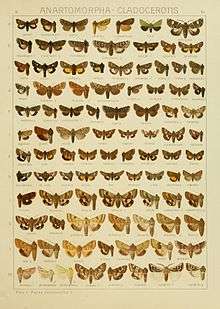Heliothis nubigera
Heliothis nubigera, the eastern bordered straw, is a species of moth of the family Noctuidae. It is found in all kind of arid areas in the Palaearctic ecozone. It is found in all the Levant countries.
| Heliothis nubigera | |
|---|---|
 | |
| Heliothis nubigera in Seitz ie Gross-Schmetterlinge der Erde figure 50l | |
| Scientific classification | |
| Kingdom: | |
| Phylum: | |
| Class: | |
| Order: | |
| Family: | |
| Genus: | |
| Species: | H. nubigera |
| Binomial name | |
| Heliothis nubigera Herrich-Schäffer, 1851 | |
| Synonyms | |
| |
Technical description and variation
The wingspan is 35–40 mm. Forewing greyish ochreous; reniform stigma dark grey, attached to the grey costal median spot; orbicular annular with grey centre; outer line lunulate dentate, the teeth whitish, separated by a brown shade from the subterminal line; hindwing pearly white with broad blackish outer border, containing a double whitish blotch between veins 2 and 4; veins and cell spot dark; fringe white.[1]
Biology
Adults are on wing year round. There are probably two generations per year.
Larva red-brown, dorsal line darker, subdorsal band alternately black and white; a diffused brown sublateral band. The larvae are polyphagous on various wild herbaceous plants. Recorded food plants include Zygophyllum, Echinops, Lonicera, Atriplex halimus, Retama raetam, Suaeda asphaltica and Zygophyllum dumosum.[2]
References
- Seitz, A. Ed., 1914 Die Großschmetterlinge der Erde, Verlag Alfred Kernen, Stuttgart Band 3: Abt. 1, Die Großschmetterlinge des palaearktischen Faunengebietes, Die palaearktischen eulenartigen Nachtfalter, 1914
- "Robinson, G. S., P. R. Ackery, I. J. Kitching, G. W. Beccaloni & L. M. Hernández, 2010. HOSTS - A Database of the World's Lepidopteran Hostplants. Natural History Museum, London".